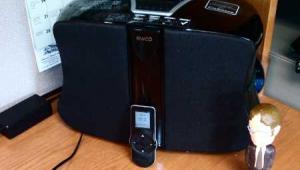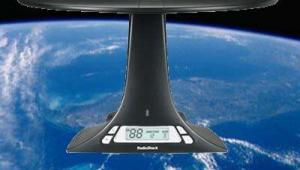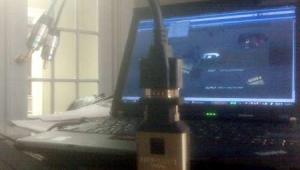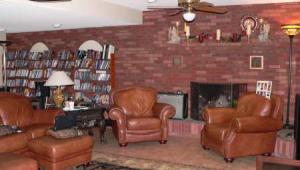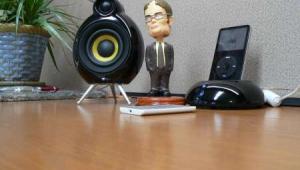Polk I-Sonic Entertainment System 2 Review

Let's cover the features list. A dock with an alarm clock makes the ES2 a good choice for the limited real estate in that crowded, overpriced urban studio you live in, if that's you. Both AM and FM analog and HD radio bands are available. There are two antenna included for FM, a basic dipole which is hard to elegantly deploy (it's a big "T" shaped wired that really should be kept in that "T" form for best reception) and an easier to deploy straight wire which you can hide, but forget about getting any stations with it unless you live next to a broadcast tower. The AM antenna is your basic black rectangular piece which will work well enough for yak-yak radio.
FM reception is excellent for a $500 do-everything device. I was able to hone in on my absolutely favorite radio station (104.1 WMRQ) in HD sitting on my back patio. I could also pick up many other stations with relatively strong signals in HD and a few more distant stations in analog. But the ES2 doesn't have the draw of DaySequerra or classic McIntosh tuner. It's a good time toy and that's exactly what you'll get with it, a good time.
Of course it is an iPod dock and that works well as designed, although like most docks, your approach should be careful and steady like a US made space shuttle docking with a Soviet era made Mir space station, least you bust something. Most people willing to drop the $500 clams for the ES2 are likely on their 2nd or 3rd iPod and will keep one of their older ones (you know Apple, with the batteries that no longer remain charged beyond two songs) more or less permanently plugged in. Of course, that would work (and that's what I did in my office), but as Polk points out, two of the newest models, the new Nano (8 and 16 GB) and the Classic (120 GB), can take advantage of a special (and very exciting) feature Polk and iTunes have built in, called Tagging.
Here's how Tagging works. If you're listening to an HD station and a song comes on that you like, either push the front panel "tag" or the same button on the remote. Next time you synch your newer Nano or Classic to iTunes, you'll be shown an unfulfilled playlist from which you can go ahead and fulfill your wildest endorphantasies. Beats what I do now which is fire up the recorder in my Blackberry and point it at a radio for later lyric degoogling or a round of "name that tune" with one of the kids.
I have two older 30 GB iPods, one battery-challenged that I kept in the ES2 when it was used in my out-of-town office, and the other, this one socially-challenged, that endured many sweaty one hour runs. One weekend, planting annuals outside, I plugged the smelly one into the I-Sonic and fired up a playlist. By the way, you have to start the playlists on the iPod, there is no control on the ES2 panel or remote to navigate the iPods menus.
Since I was walking to and fro around the yard, I had the Polk cranked up pretty loud. Make that really loud, although Polk provides no specs for power, radio sensitivity or anything else in their user manual, so I can't put a number on it. Surprisingly, the little table top ES2 cranks out lots of mid-bass power from its four speaker system (more on that later) and down-firing bass port even outdoors. Unfortunately, my aging iPod didn't sit firmly on the unit and the bass vibrations knocked the iPod seating out of place enough a few times to freeze the iPod, force me to administer a hard reboot and basically, harsh my mellow. A few days later, I went kayaking with that same iPod and got it wet enough to send it code blue. The front controls of that iPod don't work at all now, so it's bed-ridden in the MStation Tower dock where it will live out its golden years playing shuffle.
I decked out with a new Nano (8 GB in glorious blue) the next day and downloaded my workout songs into it. The Nano mates much tighter with the Polk and even cranked to the max, it never disconnected. That’s the good news. The bad news is, track advance and pause/play don't work from the remote now. Volume works fine still, so – not the remote. I noticed that the usefulness of the remote is very dependent on vertical angle. Too high or low from on axis and the Polk won't respond. On the other hand, I could hit it from about 20 feet away if the angle was right.
Polk has designed a spacious sounding table-top unit by including both front firing and rear firing speakers. In fact, those rear speakers need room to breathe. I first put the I-Sonic in the corner of the credenza behind me, but the bass and midrange seemed boomy and the sound closed in. Moving it to a higher perch with a few feet behind it before encountering a hard surface improved the sound significantly. Another improvement if you're going to crank it to the max, as I did when outside – lower the bass. Polk clearly has designed the ES2 to work in environments (offices, bedrooms with tender eared spouses, etc) where a little extra bass boost would help counteract the human ear's built in and documented insensitivity to frequency extremes at low volumes.
I ran into some distressing sounds coming from the I-Sonic's speakers at one point. I thought I may have damaged a driver by overplaying the system, so I backed off the bass and that helped but didn't completely eliminate the problem. I've run into this before with other speakers. Usually I shove the hand of small child into the port and have them fish around for a speaker wire that's being buzzed when the speaker is in deep excursion. I'm pretty sure this is the case because after putting the unit back in the house and then dragging it outside a few hours later, the buzz was gone (things shift – just ask any woman in her forties).
I was glad I hadn't blown a driver – I remember one particular review of the Polk LSi-9 (that was a rave, and I still recommend that speaker to this day!) where I blew three speakers in my home theater setup. At least I got to try all the different wood finishes that time, but seriously, a guy can get a reputation.
Polk gives you one year on the warranty, something I'd expect for a $500 unit. I love the ability to "tag" a song off the HD radio, heck I love the HD radio too. The Boston Acoustics HD radio, one of the first table tops to come around, didn't lend much credence to the technology. But the Polk gets it right!
There's an auxiliary port too for connecting a different player as well as composite and s-video ports to see what iPod tune is playing on your TV. A two channel output exists too, so you can feed this into your stereo as well, although why you'd have the I-Sonic in the same room as your stereo is beyond me. There are cheaper docks for your stereo.
So how does it sound? Good, very good, acceptably good – yes, you're an audiophile, but unless your a total dweeb, you'll think it sounds good too. But to be fair, it doesn't have the same sonic quality as the Scandyna system I reviewed last year. That was the best sounding little system I've had in for review thus far, but all it did was play the iPod. No HD radio, no tagging, no frills. It did sound great though. But the Polk sounds perfectly fine and is more than enjoyable and lets you switch between your playlist and Clear Channels's any time you wish. And compared to the other "docks" out there, 99% of which sound anemic in the bass, the I-Sonic ES2 comes in not only near the top of any short list of recommendations for iPod docks, it comes in at #1. With a bullet.
The Polk I-Sonic SE2 is an elegant solution to the enviable problem of what do with $500. Highly recommended!
- Log in or register to post comments

